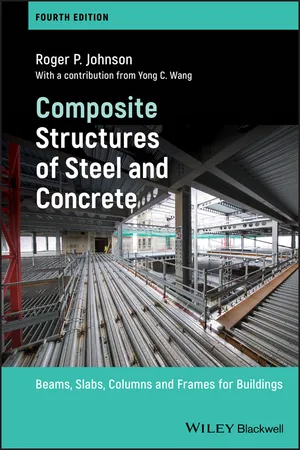
Composite Structures of Steel and Concrete
Beams, Slabs, Columns and Frames for Buildings
- English
- ePUB (mobile friendly)
- Available on iOS & Android
Composite Structures of Steel and Concrete
Beams, Slabs, Columns and Frames for Buildings
About this book
This book provides an introduction to the theory and design of composite structures of steel and concrete. Material applicable to both buildings and bridges is included, with more detailed information relating to structures for buildings. Throughout, the design methods are illustrated by calculations in accordance with the Eurocode for composite structures, EN 1994, Part 1-1, 'General rules and rules for buildings' and Part 1-2, 'Structural fire design', and their cross-references to ENs 1990 to 1993. The methods are stated and explained, so that no reference to Eurocodes is needed.
The use of Eurocodes has been required in the UK since 2010 for building and bridge structures that are publicly funded. Their first major revision began in 2015, with the new versions due in the early 2020s. Both authors are involved in the work on Eurocode 4. They explain the expected additions and changes, and their effect in the worked examples for a multi-storey framed structure for a building, including resistance to fire.
The book will be of interest to undergraduate and postgraduate students, their lecturers and supervisors, and to practising engineers seeking familiarity with composite structures, the Eurocodes, and their ongoing revision.
Frequently asked questions
- Essential is ideal for learners and professionals who enjoy exploring a wide range of subjects. Access the Essential Library with 800,000+ trusted titles and best-sellers across business, personal growth, and the humanities. Includes unlimited reading time and Standard Read Aloud voice.
- Complete: Perfect for advanced learners and researchers needing full, unrestricted access. Unlock 1.4M+ books across hundreds of subjects, including academic and specialized titles. The Complete Plan also includes advanced features like Premium Read Aloud and Research Assistant.
Please note we cannot support devices running on iOS 13 and Android 7 or earlier. Learn more about using the app.
Information
1
Introduction
1.1 Composite beams and slabs
Table of contents
- Cover
- Table of Contents
- Preface
- Symbols, Terminology and Units
- Chapter 1: Introduction
- Chapter 2: Shear Connection
- Chapter 3: Simply‐supported Composite Slabs and Beams
- Chapter 4: Continuous Beams and Slabs, and Beams in Frames
- Chapter 5: Composite Columns and Frames
- Chapter 6: Fire Resistance
- Appendix A: Partial‐interaction theory
- References
- Index
- End User License Agreement